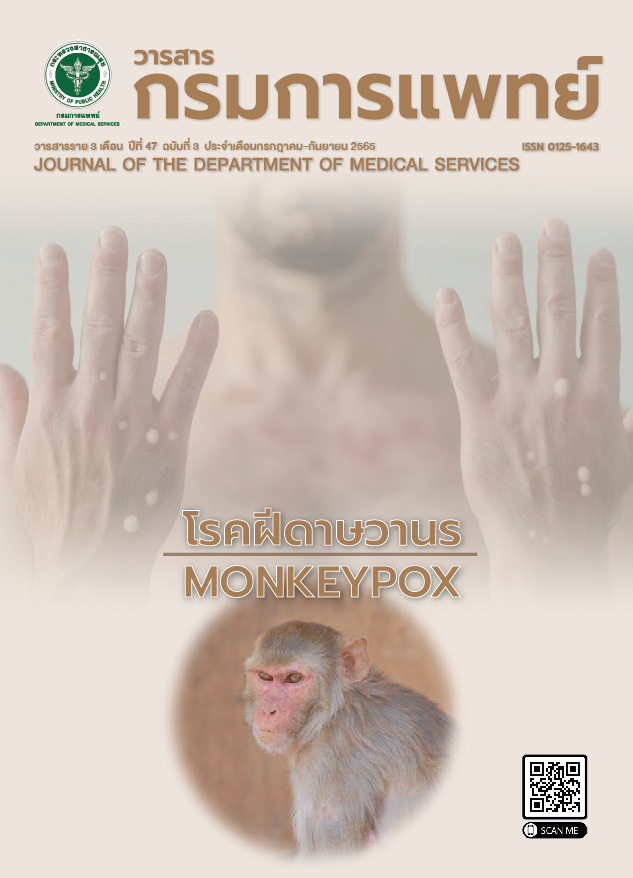The Effect of the Height of the Asana Seat on Flexion Knee Angle and Monk's Satisfaction while Sitting in a Cross-legged Posture
Keywords:
cross-legged posture, height of the asana seat, knee angleAbstract
Background: Buddhist monks usually sit on the floor in a cross-legged posture. Deep flexion of knees more than 90-degree increases mechanical loads at the knee joint, which is one of the causes of osteoarthritis of the knee. The use of a higher asana seat may decrease flexion knee angle. Objective: To find the proper height of the asana seat that decreases flexion knee angle and increases the satisfaction of the monk. Method: This was an experimental study of 50 Buddhist monks sitting on the asana seats at different heights of 5, 10, and 15 centimeters. Then the Buddhist monks were asked to answer the satisfaction questionnaire and did a knee X-ray to measure flexion knee angle. Result: While sitting on the 5 cm, 10 cm, and 15 cm height asana seats, the flexion knee angle was 129.2 ± 11.9, 128.4 ± 11.2, 126.8 ± 11.1, respectively. The difference in flexion knee angle was not statistically significant (p-value > 0.05). The satisfaction score on comfortability was 4.36 ± 0.75, 3.64 ± 1.06, 3.04 ± 1.5, and the satisfaction score on suitability was 4.28 ± 0.93, 3.32 ± 1.04, 2.56 ± 1.36, respectively. Both satisfaction scores of 5 cm height asana seat were higher than 10 cm and 15 cm height asana seats significantly (p-value < 0.05). Conclusion: The most suitable height of the asana seat in this study is 5 centimeters, nearly the same height as the commonly used asana.
References
Thambyah A, Goh JC, De SD. Contact stresses in the knee joint in deep flexion. Med Eng Phys. 2005;27(4):329-35.
Nagura T, Dyrby CO, Alexander EJ, Andriacchi TP. Mechanical loads at the knee joint during deep flexion. J Orthop Res. 2002; 20:881-6.
Maetzel A, Mäkelä M, Hawker G, Bombardier C. Osteoarthritis of the hip and knee and mechanical occupational exposure--a systematic overview of the evidence. J Rheumatol. 1997; 24: 1599-607.
โรงพยาบาลสงฆ์. รายงานประจำปี ๒๕๖๓; 2021: 28-39
D'Lima DD, Fregly BJ, Patil S, Steklov N, Colwell CW Jr. Knee joint forces: prediction, measurement, and significance. Proc Inst Mech Eng H. 2012; 226: 95-102.
Kutzner I, Heinlein B, Graichen F, Bender A, Rohlmann A, Halder A, et al. Loading of the knee joint during activities of daily living measured. Journal of biomechanics. 2010; 43: 2164-73.
Roemer FW, Zhang Y, Niu J, Lynch JA, Crema MD, Marra MD, et al. Tibiofemoral joint osteoarthritis: risk factors for MR-depicted fast cartilage loss over a 30-month period in the multicenter osteoarthritis study. Radiology. 2009; 252: 772-80.
Felson DT, Anderson JJ, Naimark A, Walker AM, Meenan RF. Obesity and knee osteoarthritis. The Framingham Study. Ann Intern Med. 1988; 109: 18-24.
Felson DT, Hannan MT, Naimark A, Berkeley J, Gordon G, Wilson PW, et al. Occuaptional physical demands, knee bending, and knee osteoarthritis: results from the Framingham Study. J Rheumatol. 1991; 18: 1587-92.
Lau EC, Cooper C, Lam D, Chan VN, Tsang KK, A. S. Factors associated with osteoarthritis of the hip and knee in Hong Kong Chinese: obesity, joint injury, and occupational activities. Am J Epidemiol. 2000; 152: 855-62.
Zhang Y, Xu L, Nevitt MC, Aliabadi P, Yu W, Qin M, et al. Comparison of the prevalence of knee osteoarthritis between the elderly Chinese population in Beijing and whites in the United States: The Beijing Osteoarthritis Study. Arthritis Rheum. 2001; 44: 2065-71.
Anderson JJ, Felson DT. Factors associated with osteoarthritis of the knee in the first national Health and Nutrition Examination Survey (HANES I). Evidence for an association with overweight, race, and physical demands of work. Am J Epidemiol. 1988; 128: 179-89.
Kivimäki J, Riihimäki H, Hänninen K. Knee disorders in carpet and floor layers and painters. Scand J Work Environ Health. 1992; 18:310-6.
Virayavanich W, Alizai H, Baum T, Nardo L, Nevitt MC, Lynch JA, et al. Association of frequent knee bending activity with focal knee lesions detected with 3T magnetic resonance imaging: data from the osteoarthritis initiative. Arthritis Care Res (Hoboken). 2013; 65: 1441-8.
Amin S, Goggins J, Niu J, Guermazi A, Grigoryan M, Hunter DJ, et al. Occupation-related squatting, kneeling, and heavy lifting and the knee joint: a magnetic resonance imaging-based study in men. J Rheumatol. 2008; 35: 1645-9.
Cooper C, McAlindon T, Coggon D, Egger P, Dieppe P. Occupational activity and osteoarthritis of the knee. Ann Rheum Dis. 1994; 53: 90-3.
Tangtrakulwanich B, Chongsuvivatwong V, Geater AF. Associations between floor activities and knee osteoarthritis in Thai Buddhist monks: the Songkhla study. J Med Assoc Thai. 2006; 89: 1902-8.
Sresuriyasawad V. Can total knee arthroplasty (TKA) achieve its goal in knee flexion floor activity of Thai Buddhist monks? J Med Assoc Thai. 2012; 95: S67-71.
Downloads
Published
How to Cite
Issue
Section
License
Copyright (c) 2022 Department of Medical Services, Ministry of Public Health

This work is licensed under a Creative Commons Attribution-NonCommercial-NoDerivatives 4.0 International License.
บทความที่ได้รับการตีพิมพ์เป็นลิขสิทธิ์ของกรมการแพทย์ กระทรวงสาธารณสุข
ข้อความและข้อคิดเห็นต่างๆ เป็นของผู้เขียนบทความ ไม่ใช่ความเห็นของกองบรรณาธิการหรือของวารสารกรมการแพทย์



